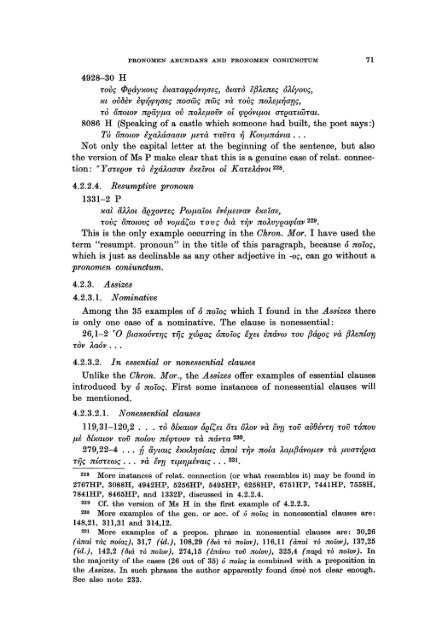Pronomen Abundans and Pronomen Coniunctum. A ... - DWC
Pronomen Abundans and Pronomen Coniunctum. A ... - DWC
Pronomen Abundans and Pronomen Coniunctum. A ... - DWC
You also want an ePaper? Increase the reach of your titles
YUMPU automatically turns print PDFs into web optimized ePapers that Google loves.
PRONOMEN ABUNDANS AND PRONOMEN CONIUNCTUM<br />
71<br />
4928-30 H<br />
iOVÇ tPeáyuovç lua-ratpeóvrweç, &aio l{JÀeneç aUyovç,<br />
Ul ov(jèv bp~tp'Y)aeç noawç nwç và iOVÇ nOÀep,~anç,<br />
iO önoLOv n(2iiyp,a ov nOÀep,oiJv ol tpeÓVlp,Ol aieailw-ral.<br />
8086 H (Speaking of a castie which someone had built, the poet says:)<br />
To önoLOV lxaÀáaaaLV p,eià iav-ra ij Kovp,návla . ..<br />
Not only the capital letter at the beginning of the sentence, but also<br />
the version of Ms P make clear that this is a genuine case of relat. connection<br />
: "Y aueov iO lxáÀaaav lUÛVOl ol K aieÀávol 228.<br />
4.2.2.4. Resumptive pronoun<br />
1331-2 P<br />
uat äÀÀOl äexov-reç Pwp,aiol lvép,elvav lueiae,<br />
iOVÇ önoLOvç ov vop,áCw iOVÇ (jlà i~V noÀvyeatp{av 229.<br />
This is the only example occurring in the Chrono Mor. I have used the<br />
term "resumpt. pronoun" in the title of this paragraph, because ó noioç,<br />
which is just as declinable as any other adjective in -oç, can go without a<br />
pronomen coniunctum.<br />
4.2.3. Assizes<br />
4.2.3.1. Nominative<br />
Among the 35 examples of ó noioç which I found in the Assizes there<br />
is only one case of a nominative. The clause is nonessential:<br />
26,1-2 '0 {Jlauovvi'Y)Ç iijÇ xweaç ónoioç ëXel lnávw iOV {Já(2oç và (JÀen{an<br />
iOV Àaóv . ..<br />
4.2.3.2. In essential or nonessential clauses<br />
Unlike the Chrono Mor., the Assizes offer examples of essential clauses<br />
introduced by ó noioç. First some instances of nonessential clauses wil!<br />
be mentioned.<br />
4.2.3.2.1. N onessential clauses<br />
119,31-120,2 ... iO lJtuaLOv Óe{Cel Oil öÀov và ëvn iOV avOivi'Y) iOV iónov<br />
p,è lJtuaLOv iOV no{ov nétpiovv ià náv-ra 230.<br />
279 , 22 - 4 ... TI • aytalç " eUUA'Y)atalç ." anal • \ i'YjV \ nota " Aap, {J avop,ev , ia \ p,vai'Y)ela ,<br />
r:ijç ntaTEwç ... và Ëvn Ttf-l'YJIlÉvatç . .. 231.<br />
228 More indtanees of relat. connection (or what resembles it) may be found in<br />
2767HP, 3088H, 4942HP, 5256HP, 5495HP, 6258HP, 6751HP, 7441HP, 7558H,<br />
7841HP, 8465HP, <strong>and</strong> 1332P, diseussed in 4.2.2.4.<br />
229 Cf. the version of Ms H in the first example of 4.2.2.3.<br />
230 More examples of the gen. or acc. of ó noïoç in nonessential clauses are:<br />
148,21, 311,31 <strong>and</strong> 314,12.<br />
231 More examples of aprepos. phrase in nonessential clauses are: 30,26<br />
(ànal Tàç nolaç), 31,7 (id.), 108,29 (&à Ta no ïov) , 116,11 (ànal Ta no ïov) , 137,25<br />
(id.), 142,2 (&à Ta noïov), 274,15 (ènávw ToU nolov), 325,4 (na(!à Tcl noïov). In<br />
the majority of the cases (26 out of 35) ó noïoç is eombined with a preposition in<br />
the A88ize8. In sueh phrases the author apparently found ónov not clear enough.<br />
See also note 233.
















